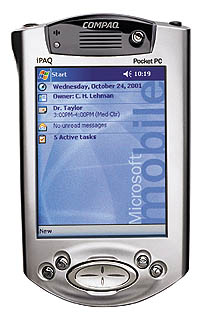HP iPAQ 3900 Series
Champion Pocket PC puts on a stunning display
(Pen Computing Magazine, December 2002 issue) --
Every kind of computer has one machine that defines its genre. You can glance at an outline and immediately identify what it is and when it is. For the Pocket PC, this machine is unquestionably the iPAQ 3600. One could argue that this machine single-handedly saved Pocket PC from an untimely demise since, despite Microsoft's best intentions, none of the previous machines from any maker were sexy. The iPAQ was, and still is, a truly sexy machine.
 With a substantial share of the handheld market and a new corporate parent, the iPAQ charged ahead into new technological territory, a space traditionally occupied by small notebooks. After the 3600 came the somewhat revised 3800 series, whose smoky-black plastic forehead housed a Bluetooth radio and an SD memory card slot. It was arguably less attractive than its predecessor, but we all got over than in about a month. The new capabilities were so welcome that we all stopped noticing the altered aesthetics and just got on with it. We all thought the 3800's reflective TFT display was a peak achievement and that it could not get any better.
With a substantial share of the handheld market and a new corporate parent, the iPAQ charged ahead into new technological territory, a space traditionally occupied by small notebooks. After the 3600 came the somewhat revised 3800 series, whose smoky-black plastic forehead housed a Bluetooth radio and an SD memory card slot. It was arguably less attractive than its predecessor, but we all got over than in about a month. The new capabilities were so welcome that we all stopped noticing the altered aesthetics and just got on with it. We all thought the 3800's reflective TFT display was a peak achievement and that it could not get any better.
It did. The new iPAQ 3900 features a transflective TFT with an LED backlight, and the result is sensational. I'm holding both machines in my hands right now and I'm just shaking my head, wondering how they can possibly top this. It's as good as the best notebook computer display you've ever seen, only you can read it in direct sunlight. Phenomenal.
But the 3900 isn't just about the new display. It's the first iPAQ powered by the latest ARM-cored Intel chip, the 400Mhz PXA250. That's potentially twice the speed of the 3800, but that's not how it really works out. The new chip can run that fast, but only does so when (a) the power management logic tells it that it can and (b) the application that is currently running has been recompiled to take advantage of the chip. The new chip is based on version 5 of the ARM core, offering not only doubled speed but doubled cache and integrated peripheral logic for greater efficiency. Bottom line is that you won't lose any appreciable battery life compared to a 206Mhz StrongARM-based iPAQ, since the PXA250 consumes about half the juice of the older chip when running flat out. For your everyday, Pocket-whatever application, you probably won't notice any real speed difference. As new media players come online that have the necessary PXA250 extensions, then you'll see some pretty exciting stuff you most likely never imagined you'd see on a handheld, like flawless 24 frame-per-second full screen video playback, mini-3D flythroughs of architectural interiors, and super-realistic action games.
Improved data security and SDIO
More than once, I've given up on relying on a Pocket PC as my daily driver due to one major flaw: the things would get their batteries low, or an application would get its knickers in a twist about something, and the thing would simply lose everything I'd ever scrawled into it. Inexcusable behavior from the most personal of computers, I'd say. On one memorable occasion, I lost an entire week's worth of appointment schedules and notes for a conference the night before it began. It's a wonder that I didn't hurl that thing out the hotel window.
I'm glad I didn't, though, since HP would probably not have sent me this 3900 to review. I'm happy to report to you that somebody at HP is listening to our cries out here in the real world, and they've added 20MB of nonvolatile flash memory that can survive a cold boot. You can actually rely on your data being there.
Another improvement seems small now but may be hugely important to you soon. The SD memory slot is now an SD expansion slot, meaning it now supports the SDIO spec to allow the use of expansion cards as well as ordinary memory cards. Imagine a GPS receiver, a WiFi card, or a tiny camera sprouting from your iPAQ. It'll all be here soon.
True believers
True handheld computing believers -- and I count myself as one of these -- always have their machines at their side, even at home watching TV. For these maniacs, HP has built in to the 3900's 48MB of ROM a programmable, universal remote control called Nevo. This is simply an outstandingly useful piece of code. I had my whole home theater system completely at my mercy within minutes.
HP managed to keep all the winning charm of the iPAQ while pumping up the performance to unheard of levels. And they maintained complete physical compatibility with all those expansion jackets that have been such an important part of the machine's success in corporate, healthcare, and industrial markets. The only bad news is that it lists for a sobering US$750. Considering all this machine can do for you everyday, the steep price is not necessarily a deal breaker. Once you look at that display, you'll probably just grin like the true believer that you are and hand over your credit card . -David MacNeill
Contact: Hewlett Packard www.hp.com
|


 With a substantial share of the handheld market and a new corporate parent, the iPAQ charged ahead into new technological territory, a space traditionally occupied by small notebooks. After the 3600 came the somewhat revised 3800 series, whose smoky-black plastic forehead housed a Bluetooth radio and an SD memory card slot. It was arguably less attractive than its predecessor, but we all got over than in about a month. The new capabilities were so welcome that we all stopped noticing the altered aesthetics and just got on with it. We all thought the 3800's reflective TFT display was a peak achievement and that it could not get any better.
With a substantial share of the handheld market and a new corporate parent, the iPAQ charged ahead into new technological territory, a space traditionally occupied by small notebooks. After the 3600 came the somewhat revised 3800 series, whose smoky-black plastic forehead housed a Bluetooth radio and an SD memory card slot. It was arguably less attractive than its predecessor, but we all got over than in about a month. The new capabilities were so welcome that we all stopped noticing the altered aesthetics and just got on with it. We all thought the 3800's reflective TFT display was a peak achievement and that it could not get any better.